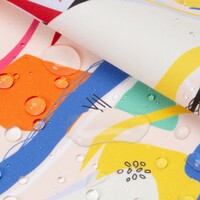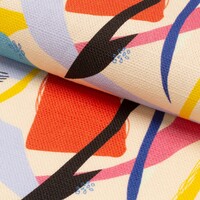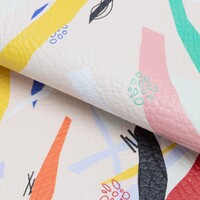Related:
Back to Site Stores ({{popupVm.storeTotalCount}})
Artists ({{popupVm.artistTotalCount}})
Create your own personalized tablecloth with this range of tablecloth fabrics. Why have a plain white fabr... Read More
Ships in 1 - 2 days
US Shipping $9.95
Everything made to order
Whether you are looking to dress or protect your table, you are bound to find the ideal material in this hand-picked tablecloth fabric range.
Browse our range of tablecloth fabrics
Medium weight, stiff with no stretch, non-fray, shiny and waterproof
100% polyester
Medium weight, matte and smooth with no stretch, water resistant
100% polyester
Medium weight with no stretch, matte and smooth, no-fray and waterproof
100% polyester
Light weight, non-fray and non-stretch, stiff, smooth, matte and waterproof
100% polyester
Light weight, smooth with no stretch, matte and waterproof
100% polyester
Medium weight, stiff and matte, opaque with no stretch. Slightly muted colors due to Pigment print. Print sits on top of fabric.
95% cotton 5% linen
Heavy weight and non-stretch, stiff, smooth and matte, non-fray, fire retardant and waterproof
100% polyester
Heavy weight, stiff with no stretch, smooth, matte, opaque and waterproof
100% cotton
Heavy weight, soft and stretchy, matte and opaque, fire retardant and water resistant.
85% PVC 15% Polyester
Care instructions
No Dry Cleaning, and No Soaking.








Tablecloths have been used for hundreds of years; in many European countries, a white or mostly white tablecloth fabric was used as a standard covering for a table. In the medieval period this would be a high-quality linen tablecloth fabric or cotton - still in white - and would represent a wealthy household. Over the course of history, fabric for table cloth became more and more common in almost all social classes, excluding only the very poorest, and tablecloths began to get more elaborate, be made from different materials, with patterns and colours being introduced. Now that tablecloths are no longer a sign of wealth, their purposes can vary greatly; some are to dress up a table, some to protect it, and some to be easily wiped clean - especially when there are little ones around.
Tablecloth fabrics are all printed digitally in our UK studio, your custom design is printed onto the white fabric tablecloth, in water-resistant splendour. You can then choose to have your customised tablecloth fabric hemmed, with either a folded hem using a straight stitch or an overlocked hem. If you want to finish your tablecloth fabric yourself, you can have it sent to you exactly as it comes off the printer, or with the white edges removed and your design cut on the line.
Please note when selecting Cotton Linen, due to the fabrics nature and our processing methods there may be occasional small white dots. This is where pieces of cotton fluff have lifted to reveal the unprinted base. This will not affect the strong colours and detailed nature of your printed fabric for tablecloth.
We print at 200dpi, which is a good combination of quality and file weight. Ideally, your image should be scaled to 100% at 200dpi; this means that no resizing of your file occurs, preventing any interpolation. Our design interface will have a quality marker next to the design that you have uploaded, this will change color using a traffic light system and display a message. The message will let you know if the resolution is too low or if you have a good quality image.
When you upload your design our system will automatically scale it to fit your chosen fabric dimensions. In the ‘Product Image’ tab, the displayed dimensions under ‘Print Size’ will show the dimensions of the piece of fabric that you are ordering. For image/design dimensions you need to see the ‘Images & Text Tools’ tab. You can see and edit the dimensions of the image under the quality information next to the thumbnail.
We advise providing images in the RGB color space. Specifically using the sRGB image profile, to achieve best color results. What does this mean? In your editing software, choose RGB as the working space and assign the image profile as sRGB (full name sRGB IEC61966-2.1)
For most of our fabrics, there is no limit on the length of the fabric that you can order. We have a preview design window set up to 10 yds max to visualize the print, but that's not a print limit. If you'd like to order more, increase the quantity (x2 for 20 yds or x4 for 40 yds for e.g.) and then you can order as much as you'd like, with a built in automatic volume discount too. The maximum print width of each fabric can be found on the individual fabric pages or in our design interface.
Yes, that might help you! Always incorporate any extra space or borders into your purchased fabric size. We trim squarely around fabric samples and fabric prints, leaving approximately 0.2" white space. Cutting neatly on the line has an additional fee.
Crocking, which is fading along the creases, often after washing or heavy use, occurs when you digitally print on natural fabrics - more so when dark or dense colors are used. It can be minimized by using a cool hand wash instead of machine washing as the tumbling of the machine is the main cause of this. To avoid entirely, we would advise using a poly fabric.
Our organic fabrics do not have any coatings that the non-organic fabrics have. This means the ink absorbs into the fibers, reducing the color strength slightly (by approx. -40%). For super-strong colors, we recommend a non-organic natural fabric.
Unfortunately not; we like to test meticulously so that we know what gets the best results on our fabrics, and our facilities cater perfectly to them. We do however print sublimation transfer paper to order, and if you have access to a heat press you can press your own fabrics easily.
For multi-colored or very detailed files we recommend using a tiff format, but they must be flattened. For simple colors and low detail files, a jpeg is fine.
Just like many fabric printing processes, there is the potential for shrinkage. Depending on the fabric, please expect and allow between 2-8% shrinkage which you need to plan for in your dimensions. This percentage can vary from print run to print run and between fabrics, so we would advise to order a little more material than you require for your project.
We do not offer to print on both sides of the fabric, as a lot of our fabrics are semi-transparent or have some show through. This wouldn't work with double-sided printing. This is not a service that we offer on any of our fabrics.
At the moment no, our labels are all printed on the same satin fabric. We may introduce more in the future, but for now, this is the best choice. The labels are all cut the same way. You can order the fabric of your choice and make the labels yourself, but we do not cut different fabrics into label format.
With environmental consciousness in mind, our fabrics are all printed using completely water-based inks. This means no chemicals or solvents are used. Our heat fixing procedure fixes the colors and prints, avoiding the downsides of steaming, such as excess or contaminated water returning into the waste system. We have one facility where we conduct all the printing, production and fulfillment. Rather than roll the fabrics, or send them in a tube, we fold them before they are sent out to you. This saves over 150 tubes a week, as well as a lot of space on the delivery van. (For delicate fabrics we ensure to package appropriately).
We work at improving our color profiles all the time. Though rare, it may happen that from one print run to another, and there could be slight color differences, this is normal and part of the process when we are constantly improving. It is extremely unlikely that there will be a huge difference (like orange instead of red for example). Please bear in mind such color variations can be intensified from fabric to fabric due to the varying grains and textures of the fabric. This is due to the construction of the materials as well as the print methods that have to be altered slightly for more delicate, natural textiles.
We have a full Cut & Sew service here at Bags of Love, and are able to hem your fabric prints for a small additional charge. We create a small one- or two-fold hem that typically uses 0.2" to 0.75" (5-20mm) of material, depending on the thickness of the fabric. So, for example, if you want a finished piece of fabric that measures 39.37" x 39.37", you will need to order a size of 39.96" x 39.96" to allow for the hem (on top of that please also allow for shrinkage of min 2%). The thicker the fabric, the bigger the hem will be. You can choose to have your prints hemmed with either Black or White thread. On our silk and other light woven fabrics, one hemmed edge will be straight (vertically down the roll) and the other will be slightly rippled. The hemming material allowances are as follows and you need to make your print bigger to accommodate the hem:
All of our fabrics are cut manually by hand, with the utmost care and attention. If your fabric has a slightly uneven look on the edges or a touch of fraying, this does not indicate a flaw in the textile. It is not always possible to achieve a perfectly straight cut with certain fabrics, so please do bear this in mind when it comes to your design. If you have any queries or would like to know about our cutting methods in more detail, please get in touch and we will be more than happy to discuss them with you.
For further information about our fabrics see our FAQs.
Please note: As everything we provide is handmade to order, you may find a slight variance in the sizes.













